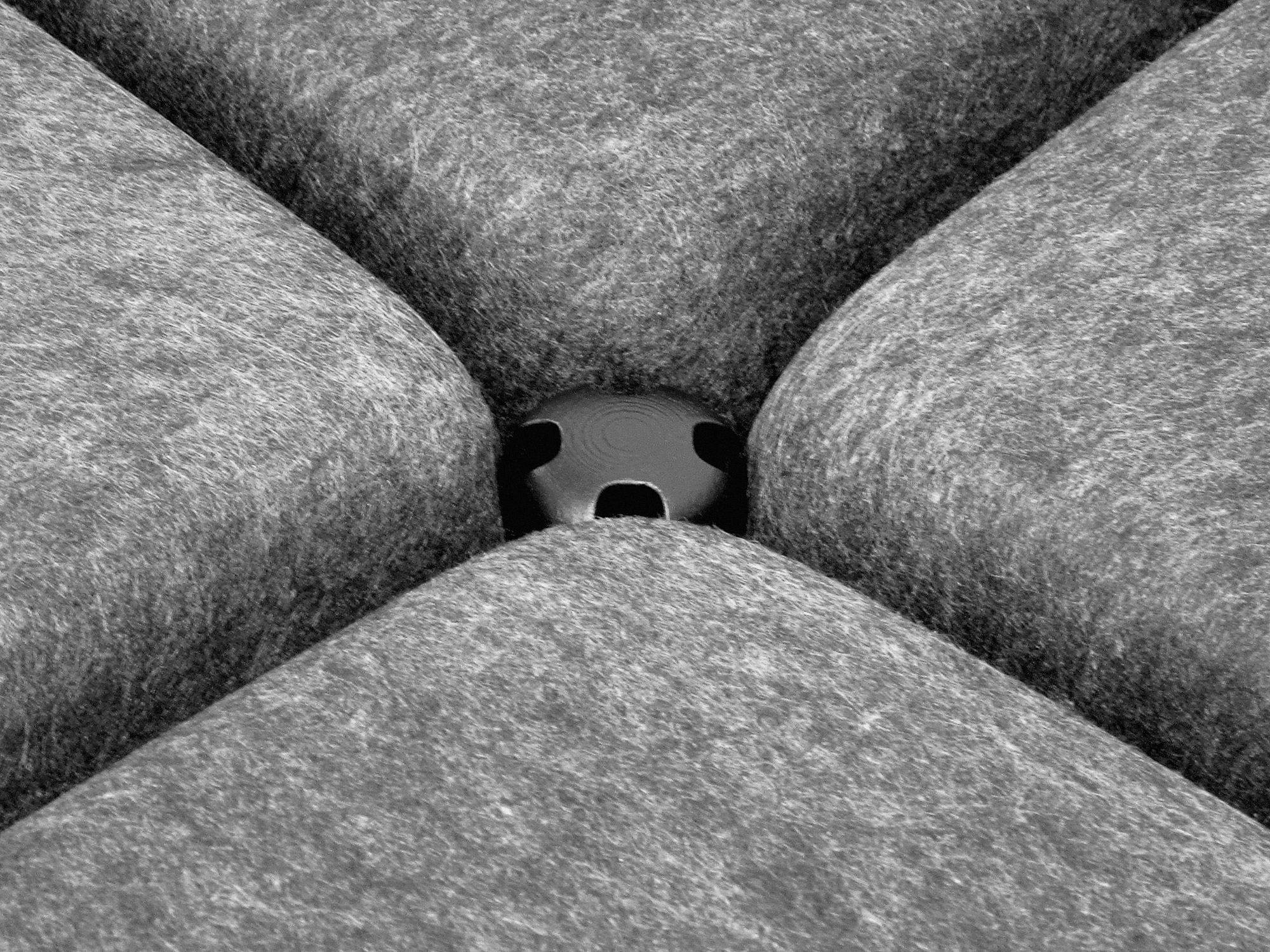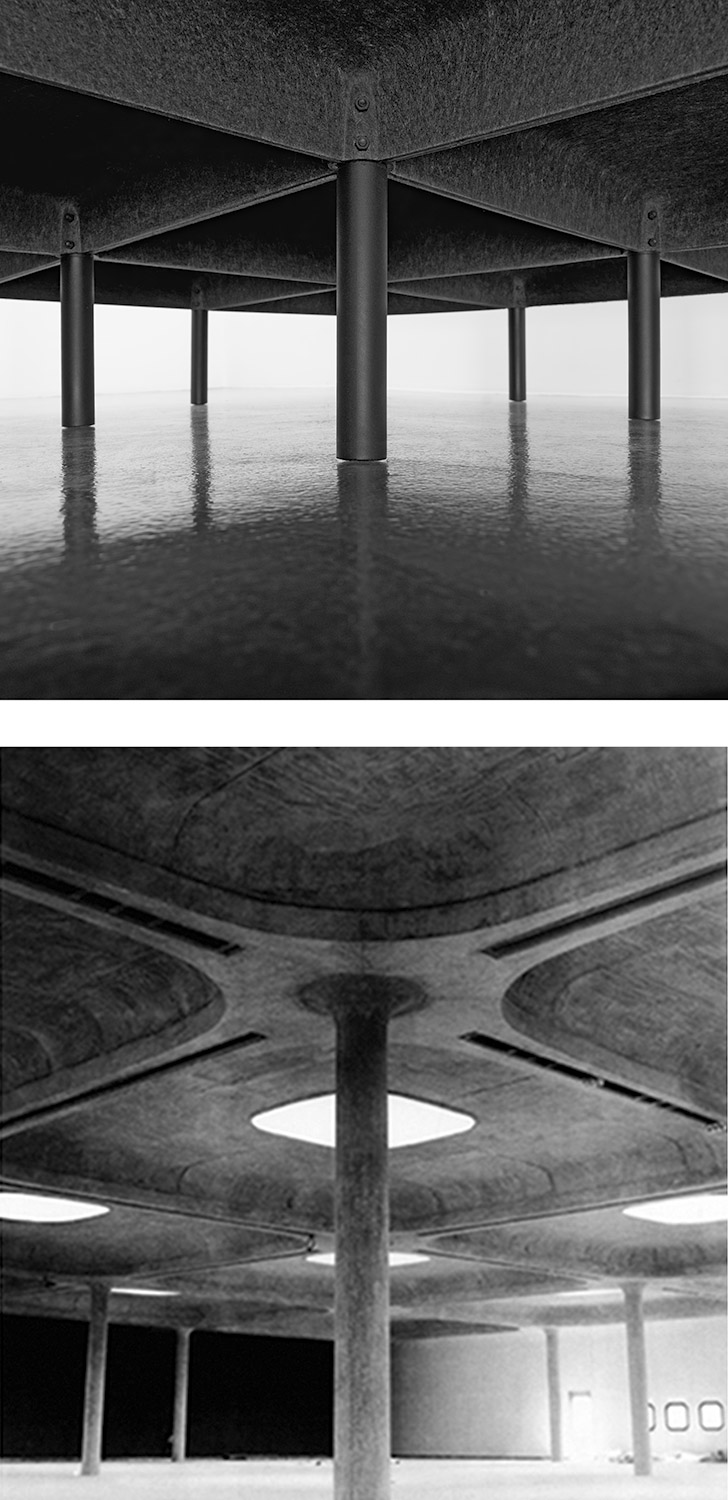Plattform
Modular bed
2019
Versteht man ein Bett als Plattform, auf der eine weiche Unterlage zum Schlafen liegt, so könnte sie aus einer Gruppe von Hockern gebildet werden, die der Größe einer Matratze entspricht. Dieser Herleitung folgend setzt sich das Plattform-Bett aus Einzelteilen zusammen, die es variabel, schnell montierbar sowie versand- und transportfreundlich machen. Aus quadratischen Elementen und optionalen Kopfteilen lassen sich Einzel- und Doppelbetten genauso zusammenstellen wie Betten für Kinder und Gäste.
Die Filzmodule werden aus erhitztem Polyestervlies gefertigt, das in eine Form gepresst wird. Formvlies ist ein Material, das im Innenraum von Autos oder auch bei Instrumentenkästen Verwendung findet: Filzartig an der Oberfläche, ist es jedoch in seiner Konsistenz recht steif und verwindungsfest. So ersetzt das Vlies die gespannte Elastizität eines Lattenrostes, wenn seine Dichte und der Anteil an Schmelzfasern richtig gewählt sind. Dabei ist es luft- und wasserdurchlässig. Die 51 × 51 cm großen Elemente werden zu einer Plattform angeordnet, ihre weitgespannten Wölbungen grenzen an die tieferliegenden, gerundeten Enden der Beine. Diese wie in „quadratischer Heftung“ strukturierte Fläche erinnert an das bekannte Capitonet-Muster aus der Polstertechnik. Ist das Relief des kapitonierten Überzugs einmal in freitragende Formvlies-Schalen übertragen, entspricht jenes Inbild der Polsterung genau den Anforderungen an ein Bett.
Die Plattform bildet eine Auflage, deren Fläche stets die der Matratze überragt. Durch den Überstand ähnelt Plattform westlichen Adaptionen japanischer Schlafstätten, den sogenannten Futon-Betten. Diese niedrigen, eine flache Matratze breit umgebenden, hölzernen Bettgestelle sollen eigentlich den Tatami-Boden repräsentieren, auf dem japanische Futons direkt aufliegen. Im Gegensatz zu den sperrigen und harten Rahmen solcher Betten stellt Plattform mit seiner weichen Haptik und seiner federnden Oberfläche eine überaus leichtgewichtige Alternative dar.
If you think of a bed as a platform to support soft padding for sleeping, then it could be formed by stools arranged in a group the size of a mattress. Accordingly, the Plattform bed consists of individual parts that make it variable, quick to assemble, and easy to ship or transport. Square elements and optional headboards make it possible to assemble single and double beds as well as beds for children and guests.
The felt modules are manufactured of heated polyester nonwoven fabric that is pressed in a mold. Formfleece is a material that is used in the interiors of cars and for instrument cases: felt-like on its surface, it is nevertheless quite stiff and torsion resistant. Hence when its density and the proportion of melt fibers are chosen correctly, the nonwoven fabric can supplant the pretensioned elasticity of a slatted bed frame. In addition, it is permeable to air and water. When the 51 × 51 cm elements are arranged into a platform, their wide-spanning vaulted caps abut the lower, rounded ends of the legs. This surface, with its pattern of “square stitching”, is reminiscent of the well-known padded capitonné upholstery technique. Once the relief of the tufted covering has been translated to self-supporting, molded nonwoven fabric shells, this embodiment of cushioning corresponds exactly to the requirements of a bed.
Plattform forms a support whose surface invariably extends out beyond the edge of the mattress. This projection gives Plattform the semblance of an occidental adaptation of Japanese sleeping places, so-called futon beds. These low, wooden bed frames that broadly surround a flat mattress are supposed to represent the tatami floor mats on which Japanese futons directly lie. In contrast to the bulky and hard frames of such beds, Plattform, with its soft feel and its springy surface, is an extremely lightweight alternative.
Weiterlesen /
Read more
Text einklappen /
Close text




Modularer Aufbau der Plattform
Modular configuration of Plattform


Produktentwicklung: Formvliesmodule in der Presse, Zuschnitt der Module
Making of: pressing formfleece, cutting the modules




CNC-gefräste Massivholzbeine
CNC-milled solid wood legs

Kleine (Plattform) und große Tragwerke (Angelo Mangiarotti, Armitalia-Werk, Cinisello Balsamo, 1968)
Small (Plattform) and large structures (Angelo Mangiarotti, Armitalia Plant, Cinisello Balsamo, 1968)

King Size
